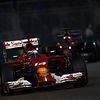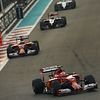Ferrari F14 T

Active: 2014
Team: Scuderia Ferrari SpA
Team: James Allison (TD), Pat Fry (ED), Nikolas Tombazis (CD), Stefano Domenicali (MD), Simone Resta (DCD), Corrado Lanzone (Head of production), Luca Marmorini (HE), Rory Byrne (Tech Advisor)
Drivers: Fernando Alonso (14), Kimi Raikkonen (7)
The F14 T is the sixtieth car built by Ferrari specifically to take part in the Formula 1 World Championship. It was designed by Chief Designer Nikolas Tombazis, along with Rory Byrne who was advising Ferrari and focused on the 2014 regulations since 2012. James Allison arrived at Ferrari only when the car was in its late design stages and therefore had little influence on its core layout.
The name comes from the combination of the current year and the introduction of the turbo-compressor in the Power Unit. The car was launched on 25 January and first his the track on 28 January at Jerez, driven by Kimi Raikkonen. Given the complexity of the regulation changes, the project, internally known as 665 took more than two years.
Ferrari's 2014 contender features front and rear pull rod suspension, similar to its predecessor with which the Scuderia finished third in the 2013 constructors' championship. Its visual appearance is obviously the result of the regulation changes with Ferrari opting for a low nose, visually very different from what other cars featured. Front wings and rear wings are also new due to the regulations with the front wing narrower and the rear wing featuring a more efficient DRS system and no more beam wing. More details can be found in the technical launch analysis of the car.
Although the external differences are striking, the largest areas of difference occur beneath the skin of the car. The new car has completely different cooling requirements from any of its predecessors. Engine oil and water radiators shrink in size to match the relatively smaller V6 internal combustion part of the Power Unit. However, new homes had to be found to accommodate an intercooler for the turbo-compressor system and to manage heat rejection from ERS components that are many times greater than their KERS antecedents. Given that more cooling allows more horsepower, but more cooling also damages downforce generation it was necessary to decide very carefully on the correct level of overall cooling for the car to render the best lap time compromise between horsepower and downforce. The team stressed repeatedly that having both the chassis and engine departments under one roof proved to be a major advantage.
The braking system has been completely redesigned to adapt the car to the change in the regulations: This has involved ensuring greater capacity on the front axle, while working with Brembo to reduce the size of the hydraulic caliper at the rear to compensate for the greater braking effort that is supplied by the ERS motor. In addition, as permitted by the regulation, the F14 T will have a brake-by-wire system for the first time to allow us to optimize pedal consistency and brake balance control as the ERS braking contribution changes during the braking manoeuvre.
The 2014 Power Units produce greater peak power than their 2013 counterparts and do so at lower RPM with higher torque. Furthermore, the regulations requires teams to fix a choice of just 8 ratios for the season. This places very different requirements on the transmission than any of the previous generation of Formula 1 cars.
Specifications
Chassis: Carbon-fibre and honeycomb composite structure
Brakes: Brembo ventilated carbon-fibre disc brakes (front and rear) and brake by wire rear brakes
Suspension: Pull-rod activated torsion springs front and rear
Electronics: FIA standard ECU and FIA homologated electronic and electrical system
Weight: 691kg (with water, lubricants and driver, without fuel)
Wheels: OZ Racing (Front: 12.0in x 13in diam., Rear: 13.7in x 13in diam.)
Tyres: Pirelli
Transmission
Gearbox: Longitudinally mounted, semi-automatic 8-speed sequential and electronically controlled gearbox with quick shift
Powertrain
Designation: Ferrari 059/3.
Type: turbocharged, 90° 1.6l V6, assisted with kinetic and heat ERS
Valves: 24 (4 per cylinder)
Rev limit: 15,000rpm
Pressure charging: Single turbocharger, unlimited boost pressure (typical maximum 3.5 bar abs due to fuel flow limit)
Bore: 80mm
Stroke: 53mm
Crank height: 90mm
Exhaust: Single exhaust outlet, from turbine on car centre line
Injection: Direct fuel injection, limited to 500bar
Weight: Undisclosed (at least 145kg)
Total horsepower: Approximately 600hp (ICE) + 160hp (ERS)
Energy recovery system: Integrated Hybrid energy recovery via electrical Motor Generator Units
Energy Store: Lithium-Ion battery solution (up to 4MJ per lap), between 20 and 25 kg







